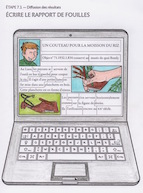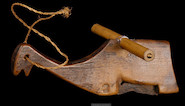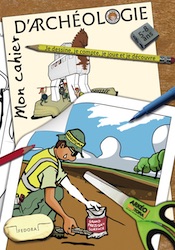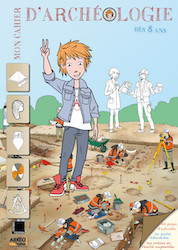Archaeologists Like to Write
- Last Updated: Tuesday, 28 June 2022 10:14
- Published: Monday, 07 February 2022 15:03
- Written by Jean-Olivier Gransard-Desmond translated by Flore Guichon
- Hits: 1449
Join Augustin, Alex, Lisa and the whole ArkeoTopia team to discover additional resources for step 7.1 in My archaeology book about writing an excavation report and a scientific paper.
Step 7.1 - Dissemination of results
Write a report then a scientific paper
Corresponding pages in MAB1 and MAB2
MAB 1, pp. 32-33 and MAB 2, pp. 38-39
More about the step’s reference artifact
 The drawings in My Archaeology Book 1 titled Writing an excavation report and of My Archaeology Book 2 titled Writing a scientific paper were inspired by the rice knife n° 71.1932.1.834 from the Musée du Quai Branly. It is about presenting the importance of the writing, especially in reports and articles in journals, which ensure the sustainable dissemination of a scientist's research.
The drawings in My Archaeology Book 1 titled Writing an excavation report and of My Archaeology Book 2 titled Writing a scientific paper were inspired by the rice knife n° 71.1932.1.834 from the Musée du Quai Branly. It is about presenting the importance of the writing, especially in reports and articles in journals, which ensure the sustainable dissemination of a scientist's research.
Writing is of vital importance in the life of an archaeologist as with any scientist. Beside the excavation notebook or the laboratory notebook, the first document that will be catalogued is the excavation report, or study report. Thanks to this document, an archaeologist can indicate what he has found, whether it is archaeological remains (excavations and inventories) or informations (experimentation results, new analysis of remains already discovered). If this report is not published to the scientific community, we will talk about the grey literature. Otherwise we will talk about a scientific article or a monograph.
There are many ways to publicize the results of an archaeological research program. However, the most important is the publication. Publishing means writing a scientific paper for a specialized journal or writing a book (a monograph) in order to present definitive results. It is a full public document unlike the grey literature. As a public document, the publication can be spread easily.
Depending the importance credited by the scientific community, the team will have access to specialized journals and publishers more or less ranked. This great importance of journals and publishers is called reputation. Thanks to this reputation, a team can get money for new research projects. Reputation is fundamental, it has a direct impact on the career of the scientist and his/her team members. This is why in this image Alex is on his computer. He is writing the synthesis of the discoveries he has made about the Tai Nua culture rice knife for the journal Science. He take the time to indicate all the artifact's dimensions, the material used to construct it, its dating, its origin, the conditions of its transfert to the museum, its use, to finish on its discoveries, with what implies the existence of this kind of artifact like flint tools, back to the prehistoric period. In order to make himself better understood, he associates illustrations to the texts and takes care to indicate the captions that correspond to each. The information provided by My Archaeology Book for 5-8 years old (MAB 1) and My Archaeology Book for 8 years old and up (MAB 2) is not the same in order to make it easier for the children to read, but also to introduce the idea of an evolution into Alex research.
This is why in this image Alex is on his computer. He is writing the synthesis of the discoveries he has made about the Tai Nua culture rice knife for the journal Science. He take the time to indicate all the artifact's dimensions, the material used to construct it, its dating, its origin, the conditions of its transfert to the museum, its use, to finish on its discoveries, with what implies the existence of this kind of artifact like flint tools, back to the prehistoric period. In order to make himself better understood, he associates illustrations to the texts and takes care to indicate the captions that correspond to each. The information provided by My Archaeology Book for 5-8 years old (MAB 1) and My Archaeology Book for 8 years old and up (MAB 2) is not the same in order to make it easier for the children to read, but also to introduce the idea of an evolution into Alex research. 
This step is also an educational support. Thanks to it, teach easily page layout making to your pupils and launch a contest like National History Day in Colorado junior. With this puzzle approach, elementary school as well as high-school students will learn a poster or slideshow presentation is like a scientific paper with:
- A title
- A text
- Illustrations with a caption for each
- Two sources at least, but more is better
Putting back together all the pieces, young ones discover that each piece have to be harmoniously integrated in order to facilitate reading. They learn a space must be left for title, illustrations, captions and sources. An educational aid to avoid chaos and elements overlaping.
Clues
The 8 clues include:
- The computer
- The title
- The text body
- Illustrations
- Captions with figure numbers
- Geometric shapes of the different parts of the article that correspond to the page layout
- Explanations given by the overall reconstruction of each unit
- The one who writes (here, Alex the archaeologist who is a scientist)
The Chaîne OpératoireMy Archaeology Book
Resources HomepageStep 7.2 - Dissemination
Oral Presentations
 |
 |
|
My Archaeology Book 1 |
My Archaeology Book 2 |

 My Archaeology Book, or MAB, is an activity workbook that combines creativity, fun and learning. Alongside young Augustin, a curious and courageous boy, children meet Alex and Lisa, two friendly archaeologists who will lead them to discover archaeology and French heritage. Each drawing illustrates a situation that Alex and Lisa might encounter at work. Depending on the age of the child and the workbook, children follow easy-to-understand symbols in order to experiment with activities such as coloring, drawing, observation games, riddles and reading in order to see the world through an archaeologist’s eyes. Alone, with family, at school or just for fun, children expand their knowledge and gain skills, all while having fun.
My Archaeology Book, or MAB, is an activity workbook that combines creativity, fun and learning. Alongside young Augustin, a curious and courageous boy, children meet Alex and Lisa, two friendly archaeologists who will lead them to discover archaeology and French heritage. Each drawing illustrates a situation that Alex and Lisa might encounter at work. Depending on the age of the child and the workbook, children follow easy-to-understand symbols in order to experiment with activities such as coloring, drawing, observation games, riddles and reading in order to see the world through an archaeologist’s eyes. Alone, with family, at school or just for fun, children expand their knowledge and gain skills, all while having fun.
On this section, you will find additional resources: color photos of archaeological documents that inspired My Archaeology Book, additional teaching documents (flip-book, websites, suggestions for classroom use, edutainement, etc.) and information on upcoming publications. Each page will be updated over time.






